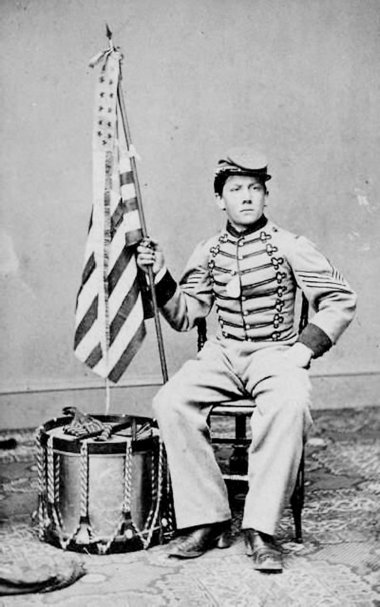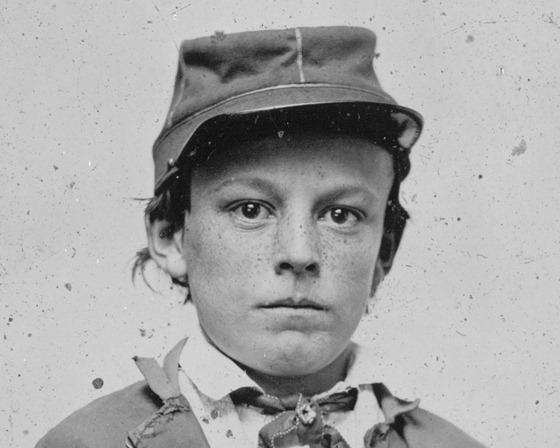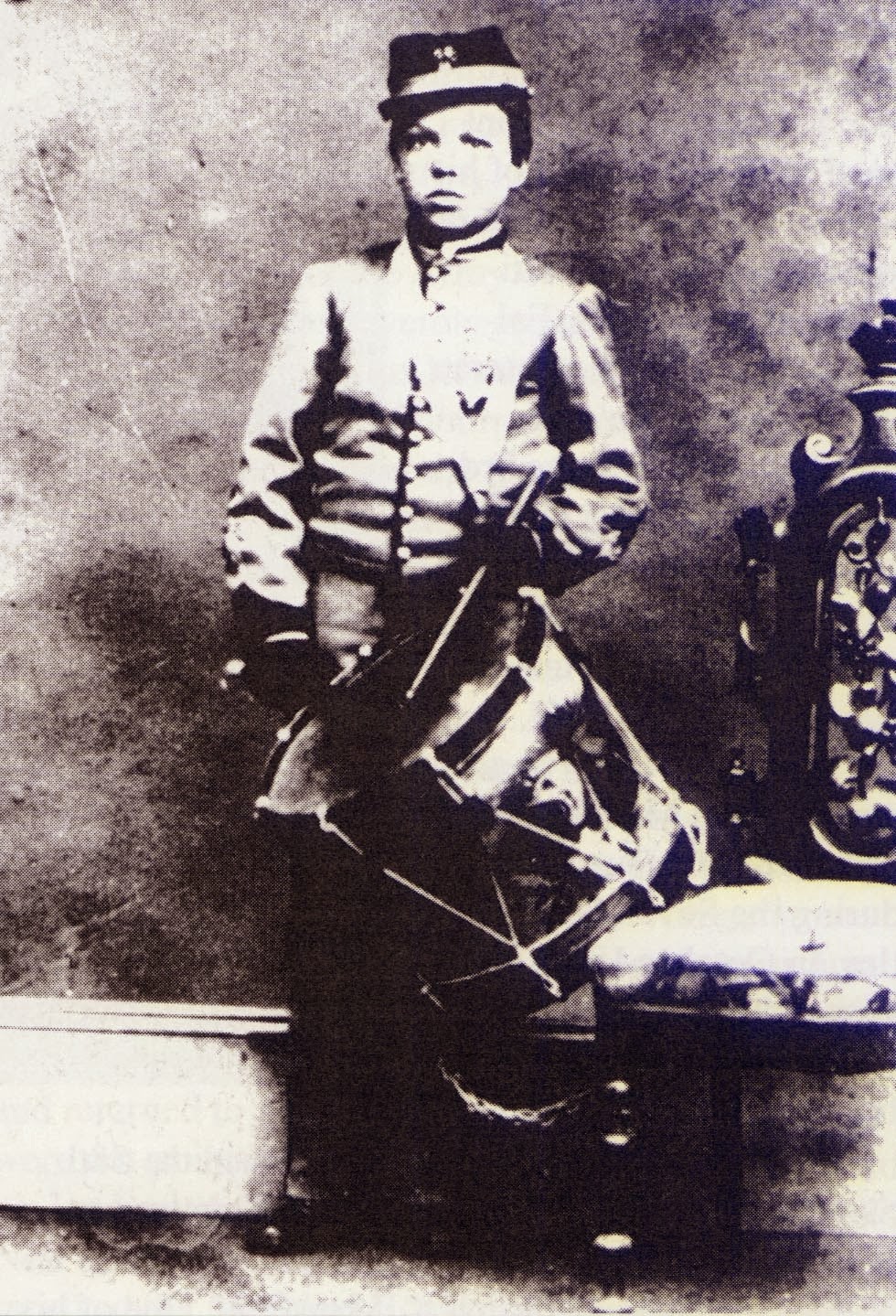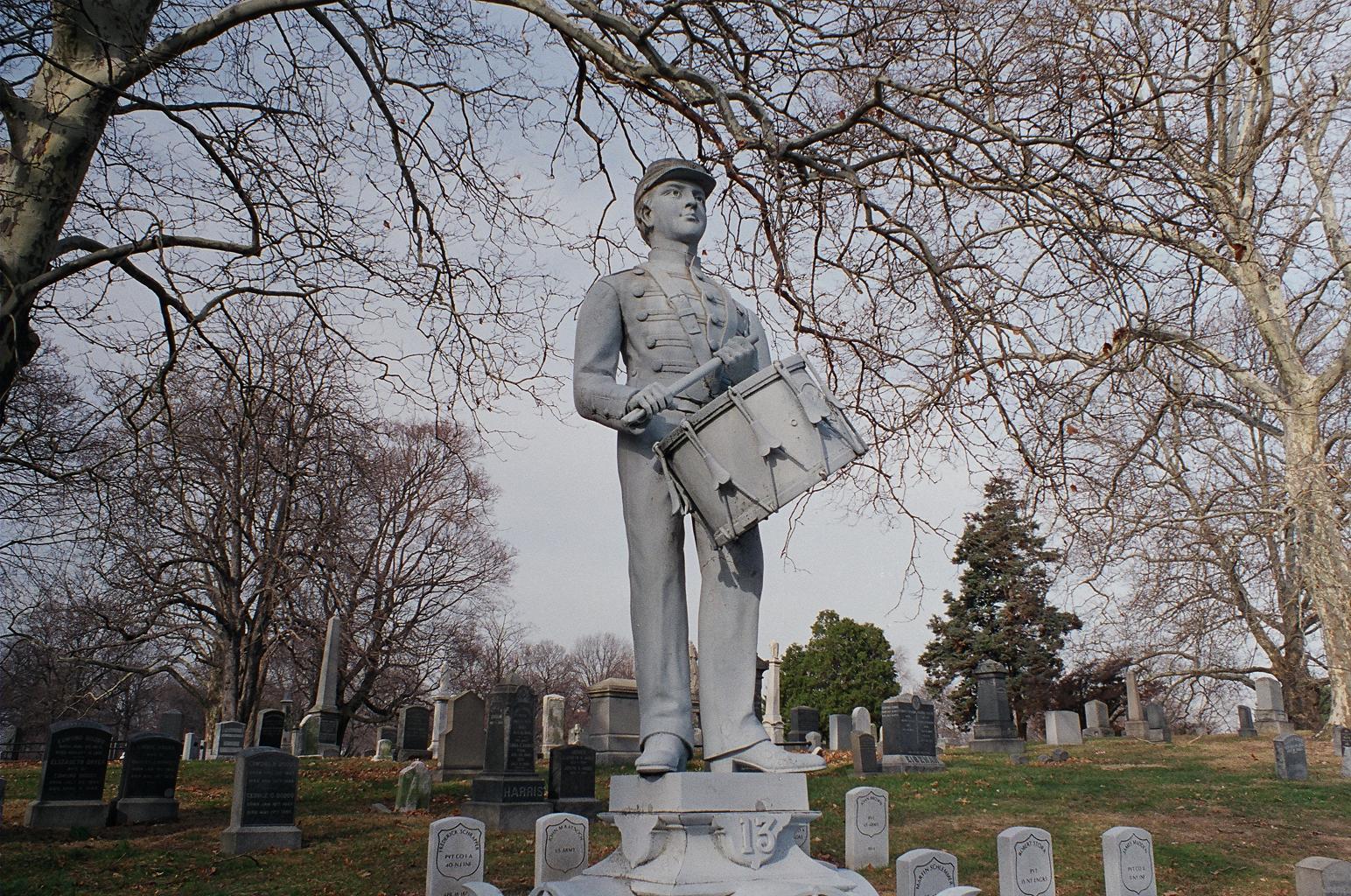A History of Civil War Drummer Boys (Part 2)
Emerging Civil War welcomes back Michael Aubrecht to share Part 2 of his article

Perhaps the most photographed drummer boy of the American Civil War, Robert Henry Hendershot, was known as the “Drummer Boy of the Rappahannock.” His nickname supposedly came from his reputed heroics at the Battle of Fredericksburg, Virginia, in December of 1862. Hendershot enlisted in Company B, 9th Michigan Infantry in March of 1862, and was taken prisoner that July at the Battle of Stones River. After his release, he joined the 8th Michigan Infantry, although he suffered from regular seizures.
While awaiting discharge for epilepsy, Hendershot arrived on the banks facing Fredericksburg where the Army of the Potomac was preparing to attack the city. The Army of Northern Virginia was waiting on the banks of the Rappahannock River, defending the city while pontoon bridges were being built. The delay enabled General Robert E. Lee to move the Confederate army into a formidable position. When the Union engineers arrived, they came under attack from rebel sharpshooters, so on December 11, 1862 the 7th Michigan Infantry volunteered to cross the river under enemy fire and drive the rebel sharpshooters from their nests. According to an account of the events:
Hendershot’s wanderings had taken him to the riverbank that morning. He later claimed that he helped push off the first boat, slipped when he tried to climb aboard, and made the voyage across the river while clinging to the gunwale. A dispatch from the scene describes “a drummer boy, only 13-years-old, who volunteered and went over in the first boat, and returned laden with curiosities picked up while there.” A correspondent for the Detroit Advertiser and Tribune wrote that the boy belonged to the 8th Michigan Infantry. Reports of the episode appeared in the press.
The young hero remained nameless until late December, when Hendershot visited the offices of the Detroit Free Press and Detroit Advertiser and Tribune, claiming to be the “Drummer Boy of the Rappahannock.” Hendershot’s story was repeated in national papers, including the New-York Tribune. Its publisher, Horace Greeley, presented Hendershot with a silver drum. For the next eight weeks Hendershot performed at the P. T. Barnum museum, and then spent a few weeks more in Poughkeepsie, New York, at the Eastman Business College, which had rewarded his heroism with a scholarship.
Many historians have questioned the story of the “Drummer Boy of the Rappahannock.” The only ones who knew the truth were the witnesses who were present at the boat’s launching and Hendershot himself. Following the war in July 1891 Hendershot posted a letter to the Grand Army of the Republic (GAR) newspaper, the National Tribune, restating his claim to the title “Drummer Boy of the Rappahannock,” as well as that of “youngest soldier.” He was by then one of the best known veteran drummer boys in the country. Despite the ongoing controversy Hendershot always stood by his claims before dying of pneumonia on December 26, 1925.

Another romantic story recalls a courageous drummer boy named Charlie Coulson. It was written by a Jewish doctor named Max Louis Rossvally. Titled “Charlie Coulson a Drummer Boy: A True Story in the American Civil War” the story reads like a testimony as the surgeon recalls his spiritual awakening inspired by an extraordinary young man. He wrote:
During the American war, I was a surgeon in the United States army; and after the battle of Gettysburg, there were many hundred wounded soldiers in my hospital, amongst whom were twenty-eight who had been wounded so severely that they required my services at once, –some whose legs had to be amputated; some, their arms; and others, both their arm and leg. One of the latter was a boy who had been but three months in the service; and being too young for a soldier, had enlisted as a drummer. When my assistant surgeon and one of my stewards wished to administer chloroform previous to the amputation, he turned his head aside and positively refused to receive it. When the steward told him that it was the doctor’s orders, he said, “Send the doctor to me.” When I came to his bedside, I said, “Young man, why do you refuse chloroform? When I found you on the battle-field, you were so far gone that I thought it hardly worthwhile to pick you up; but when you opened those large blue eyes, I thought you had a mother somewhere who might at that moment be thinking of her boy. I did not want you to die on the field, so ordered you to be brought here; but you have now lost so much blood that you are too weak to endure an operation without chloroform, therefore you had better let me give you some.
Following the boy’s valiant acceptance of death he continued:
…Hundreds of soldiers died in my hospital during the war, but I only followed one to the grave, and that one was Charlie Coulson, the drummer-boy, and I rode three miles to see him buried. I had him dressed in a new uniform, and placed in an officer’s coffin, with a United States flag over it. That dear boy’s dying words [of salvation] made a deep impression upon me.
The story concludes with a declaration by the converted doctor who found faith thanks to Charlie Coulson.
According to The Indiana Democrat (Indiana, Pennsylvania) November 15, 1883, there was a drummer boy whose youth eclipsed them all:
The Twelfth Indiana regiment possessed a pet of whom it may be said that he enjoyed renown scarcely second to that of the wide-famed Wisconsin eagle. This was “Little Tommy,” as he was familiarly called in those days — the youngest drummer boy and, so far as the writer’s knowledge goes, the youngest enlisted man in the Union army. The writer well remembers having seen him on several occasions. His diminutive size and child-like appearance, as well as his remarkable skill and grace in handling the drumsticks, never failed to fade from the memory. Some brief and honorable mention of “Little Tommy,” the pride of the Twelfth Indiana regiment, should not be omitted in these “Recollections of a Drummer-boy.”
Thomas Hubler was born in Fort Wayne, Allen County, Indiana, October 9, 1851. When two years of age the family removed to Warsaw, Indiana. On the outbreak of the war, his father, who had been a German soldier of the truest type, raised a company of men in response to President Lincoln’s first call for 75,000 troops. “Little Tommy” was the first to enlist in his father’s company, the date of enrollment being April 19, 1861. He was then nine years and six months old.
The regiment to which the company was assigned was with the Army of the Potomac throughout all its campaigns in Maryland and Virginia. At the expiration of its term of service, in August, 1862, “Little Tommy” re-enlisted and served to the end of the war, having been present in some twenty-six battles. He was greatly beloved by all the men of his regiment, with whom he was a constant favorite. It is thought that he beat the first “long roll” of the great civil war. He is still living in Warsaw, Indiana, and bids fair to be the latest survivor of the great army of which he was the youngest member. With the swift advancing years, the ranks of the soldiers of the late war are rapidly being thinned out, and those who yet remain are fast showing signs of age. “The boys in blue” are thus, as the years go by, almost imperceptibly turning into “the boys in gray;” and as “Little Tommy,” the youngest of them all, sounded their first reveille, so may he yet live to beat their last tattoo.

Most people are unaware that the youngest soldier ever to receive the Medal of Honor was a drummer boy named William H. “Willie” Johnston. Johnston was a drummer in Company D of the 3rd Vermont Infantry. During his service he participated in several events including the Seven Days Retreat in the Peninsula Campaign where he was said to have served in an “exemplary” fashion. During this event Johnston was the only drummer in his division to come away with his instrument during a general rout. His superiors considered this a meritorious feat, when his fellow soldiers had thrown away their guns. As a result, he received the Medal of Honor on the recommendation of his division commander, thereby becoming the youngest recipient of the highest military decoration at 13 years of age.
Johnston had enlisted at the same time as his father in June of 1861 and was assigned to a regiment that was camped outside of Washington. He was present for duty but was originally denied pay due to his age. Muster rolls from that time describe Johnston as being 11-years-old and five feet tall. His first engagement took place at Lee’s Mill in Virginia on April 16, 1862. His father was shot and lost a portion of his hand while charging the enemy. Following his next campaign, the Seven Days Battles from June 25 to July 1, 1862, Johnston was cited for bravery. During a retreat many men threw away their guns and equipment to lighten the load. Johnston retained his drum and was the only drummer boy to bring his instrument off of the battlefield.
Secretary of War Edwin M. Stanton presented the Medal of Honor award to Johnston on September 16, 1863. (It is said to have been directed by President Lincoln himself although no definitive proof exists). Following the Peninsula Campaign, Johnston served as a nurse in a hospital in Baltimore and was transferred to Company H, 20th Regiment of Veteran Reserve Corps, where he played in the regimental brass band as Drum Major.
In tribute a statue honoring Johnston was erected in Santa Clarita, California. Some of his memorabilia (to include drumsticks) is on display at the Fairbanks Museum in St. Johnsbury, Vermont. A plaque was placed in his honor at Berkeley Plantation in Virginia in June, 2012 by the Vermont Civil War Hemlocks. The plaque reads: “At Harrison’s Landing on July 4th, 1862, Willie Johnston — age 11, 3rd Vermont Drummer Boy played for Div. review. For keeping his drum during the arduous 7 days battles, he was awarded the Medal of Honor by Sec. of War Stanton. He remains the youngest recipient of the Medal of Honor. His gravesite is unknown. Dedicated June 2012 The Vermont Civil War Hemlocks.” (Harrison’s Landing is located at Berkeley Plantation in Virginia.)
Clarence MacKenzie was a mere 12-years-old when he marched off to war as a member of Brooklyn’s Thirteenth Regiment. Tragedy befelled him in June of 1861 while he was encamped at Annapolis, Maryland. It was during a training drill that MacKenzie was accidentally struck by a stray ball fired by his fellow soldiers. As a result he became Brooklyn’s first casualty of the Civil War. MacKenzie’s body was returned home and buried in a public lot on the Hill of Graves at Green-Wood cemetery. He was later relocated to the Soldiers’ Lot which Green-Wood donated specifically for Civil War Veterans. His grave is marked with a striking white bronze monument forged in his likeness. The ornate pedestal carrying the statue stands approximately ten feet in height and is inscribed: “ERECTED BY THE DRUM AND BUGLE CORPS OF THE 13TH REGT. N.G., S.N.Y., IN MEMORY OF CLARENCE D. MACKENZIE, BORN FEB. 8, 1849, DIED AT ANNAPOLIS, MD., JUNE 11, 1861, AGED 12 YRS, 4 MOS, 3 DYS.”

On the Southern side, an 11-year-old drummer in the Confederate Kentucky Orphan Brigade, known only as “Little Oirish,” was credited with rallying troops at the Battle of Shiloh by taking up the regimental colors at a critical moment and signaling the reassembly of the line of battle.
Another noted drummer boy was Louis Edward Rafield of the 21st Alabama Infantry, Co. K, known as the “Mobile Cadets.” He enlisted at the age of 11, and at age 12, at the Battle of Shiloh, he somehow lost his drum. He managed to commandeer a drum from the opposing troops and kept on going, thus earning the title of “The Drummer Boy of Shiloh.”
As the years passed, the drum was eventually replaced on the battlefield with the bugle, although it often returned during Veteran Reunions that took place decades after the war. Many of the Civil War’s drummers had gone on to become drum majors or drum instructors themselves.
No one can dispute the service of the drummer boys who left the safety of their homes and firesides to serve their respective cause in a man’s war. It is unfortunate that their contribution is so often overlooked. Their legacy lives on. Today America’s armed forces boast some of the most talented musicians in the country, with many of them still playing traditional instruments and cadences. Military drummers are still highly respected and carry on the tradition of their instrument’s storied history that should not be forgotten.
* * *
Sources:
Albert A. Nofi, A Civil War Treasury: Being a Miscellany of Arms and Artillery, Facts and Figures, Legends and Lore, (Da Capo Press, 1992)
Bruce & Emmett Drummers’ and Fifer’s Guide (1862)
Carolyn Reeder, “Drummer boys played important roles in the Civil War, and some became soldiers” (Washington Post, February, 2012)
Charles Stewart Ashworth, A New Useful and Complete System of Drum Beating (January, 1812)
Chet Falzerano, “Historic Collectible: Civil War Drums” (DRUM! Magazine, December, 2011)
Elizabeth M. Collins, “The Beats of Battle: Images of Army Drummer Boys Endure” (Soldiers: The Official U.S. Army Magazine, December, 2013)
Gardiner A. Strube, The Rudimental Principles of Drum – Beating (1870)
Marcie Schwartz, “Children on the Battlefield: Heroism and Sacrifice” (civilwartrust.org)
Max Louis Rossvally, Charlie Coulson a Drummer Boy: A True Story in the American Civil War (188?)
Meserette Kentake, “Alexander H. Johnson: The first drummer boy” (Kentake Page, July 2015)
Robert H. Hendershot, “Drummer Boy of the Rappahannock” (National Tribune, Grand Army of the Republic (GAR), July 1891)
Robert J. McNamara, “Civil War Drummer Boys” (history1800s.about.com)
Ronald S. Coddington, “Colonel Shaw’s Drummer Boy” (The New York Times, March, 2013)
The Indiana Democrat, “Thomas Hubler” (Indiana, Pennsylvania, November, 1883) U.S.
Civil War History & Genealogy, “The Drummer Boys” (genealogyforum.com)
Michael Aubrecht is an author, as well as a drum and Civil War Historian. He has written several books including The Civil War in Spotsylvania, Historic Churches of Fredericksburg and FUNdamentals of Drumming for Kids. He also co-produced the documentary “The Angel of Marye’s Heights”. Michael lives in historic Fredericksburg. His latest project was compiling over 100 period photographs of drummer boys. Visit his blog online at https://maubrecht.wordpress.com/.
A very touching well-researched and written tribute to the drummer boy.
Great article. Obviously drummer boys were killed and maimed in battle, but did the soldiers on the field try to avoid hitting them because of their age?
I don’t think we have a definitive answer for that. Purely speculating…Humanitarian wise I would hope they would avoid shooting them. Tactically they would benefit by hampering their foes ability to communicate effectively. No total exists to my knowledge of how many drummers were killed or wounded throughout the course of the war. If I come upon it I will be sure to share.
Thank you so much. I have a drum blog at: http://www.maubrecht.wordpress.com. If you search for “Civil War” it will bring up a multitude of posts on Civil War drums and drumming. You can also view my compilation of 100 period photos of drummer boys at: http://www.pinstripepress.net/CWDrummerBoys.pdf.
Albert Woolson, the last Union Army veteran and the last Civil War veteran, was a drummer for Company C, First Minnesota Heavy Artillery. As it was so elegantly suggested, it was indeed a drummer “boy” who beat the last tattoo.
Thanks for that info. I will definitely look it up.
Pleased to find this account, as I knew little about how Civil War drummers trained or performed.
My great-grandfather Henry Clay Stoddard was a drummer with the 24th Michigan Volunteer Infantry Enlisted Aug 2, 1862, served in the 24th Reg. Michigan Volunteers, 5th Corps, Army of Potomac; saw action at Antietam, South Mountain, Brandy Station, Fredericksburg, Chancellorville, Gettysburg, The Wilderness, North Anna, South Anna, Mine Run, Siege before Petersburg and Five Forks. Was mustered out at Detroit July 29, 1865.
https://www.pinterest.com/pin/511440101414369708/?nic_v1=1aoYPJO2XnDKCcIQ%2Bxd1rmD8ZinHelVN0t%2BnzHcW7ALrbYbYcmrSJ7Hq9%2Bqldh%2BmDZ
My 3rd great grandfather was joseph henry white and enlisted at nine years and 7 months for the new Hampshire volunteers regiment company a 2nd inf. I read a lot of articles about young drummer boys but only 1 where he is mentioned. I know I read where he never spoke of his time in the war. I have his muster sheet. Would be nice to see him get recognized as a young soldier. Even if he wasn’t the youngest.